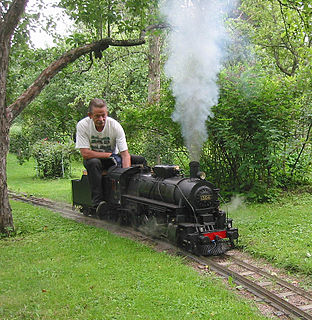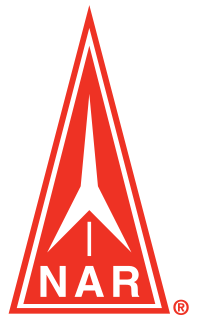Rocketry may refer to:
Rocketry may refer to:

A rocket is a vehicle that uses jet propulsion to accelerate without using the surrounding air. A rocket engine produces thrust by reaction to exhaust expelled at high speed. Rocket engines work entirely from propellant carried within the vehicle; therefore a rocket can fly in the vacuum of space. In fact rockets work more efficiently in a vacuum and incur a loss of thrust due to the opposing pressure of the atmosphere.

A solid-propellant rocket or solid rocket is a rocket with a rocket engine that uses solid propellants (fuel/oxidizer). The earliest rockets were solid-fuel rockets powered by gunpowder; they were used in warfare by the Arabs, Chinese, Persians, Mongols, and Indians as early as the 13th century.

A model rocket are small rockets designed to reach low altitudes and be recovered by a variety of means.

Estes Industries is a model rocket company that was started in Denver, Colorado, USA. The company was the first to mass-produce model rocket engines with consistent and reliable performance. It is popular among hobbyists of experimental amateur rocketry for its simple and easily accessible engines, accessories, and rocket-building kits.

Homebuilt machines are machines built outside of specialised workshops or factories. This can include different things such as kit cars or homebuilt computers, but normally it pertains to homebuilt aircraft, also known as amateur-built aircraft or kit planes. Homebuilt aircraft or kit cars are constructed by amateurs. Homebuilt computers have been built at home for a long time, starting with the Victorian era pioneer Charles Babbage in the 1820s. A century later, Konrad Zuse built his own machine when electromechanical relay technology was widely available. The hobby took off with the early development of microprocessors and, since then, many enthusiasts have constructed their own computers. A homebuilt vehicle is a wider concept than a kit car. A homebuilt vehicle is a motor vehicle built by an individual instead of a manufacturer. These machines may be constructed "from scratch", from plans, or from assembly kits. Outside of the United States people wishing to build such complex machinery often have no professional networks to rely on for spare parts, plans, or advice in the matter and therefore have to rely on their ingenuity and intuition in order to build a machine that works.

The National Association of Rocketry (NAR) is a non-profit tax-exempt scientific organization dedicated to consumer safety, youth education, and the advancement of technology in the hobby of sport rocketry in the United States. Founded in 1957, the NAR is the oldest and largest spacemodeling organization in the world with over 8,000 members and 200 affiliated clubs across the U.S. It was established in 1957 by Orville Carlisle and G. Harry Stine. It supports all aspects of safe consumer sport rocket flying, from small model rockets with youth groups to very large high power rockets flown by adult hobbyists.

High-power rocketry is a hobby similar to model rocketry. The major difference is that higher impulse range motors are used. The National Fire Protection Association (NFPA) definition of a high-power rocket is one that has a total weight of more than 1,500 grams (3.3 lb) and contains a motor or motors containing more than 125 grams (4.4 oz) of propellant and/or rated at more than 160 Newton-seconds of total impulse, or that uses a motor with an average thrust of 80 newtons (18 lbf) or more.

The Tripoli Rocketry Association (TRA) is an international organization and one of the two major organizing bodies for high power rocketry in the United States.
Motors for model rockets and high-powered rockets are classified by total impulse into a set of letter-designated ranges, from ⅛A up to O. The total impulse is the integral of the thrust over burn time.

George Harry Stine was one of the founding figures of model rocketry, a science and technology writer, and a science fiction author.
Orville H. Carlisle, a shoe salesman in Norfolk, Nebraska invented the hobby that would become known as model rocketry.
Amateur rocketry, sometimes known as experimental rocketry or amateur experimental rocketry, is a hobby in which participants experiment with fuels and make their own rocket motors, launching a wide variety of types and sizes of rockets. Amateur rocketeers have been responsible for significant research into hybrid rocket motors, and have built and flown a variety of solid, liquid, and hybrid propellant motors.

The Civilian Space eXploration Team, known as CSXT, is a team of around 30 civilians interested in private spaceflight. The team was created by Ky Michaelson. Having conducted multiple rocket launches in an attempt to establish altitude records, CSXT became the first entity to officially launch an amateur rocket into space on May 17 2004, with the successful launch of its GoFast rocket to 116 km altitude, an altitude verified by FAA analysis of the team's flight data.
Ammonium perchlorate composite propellant (APCP) is a modern fuel used in solid-propellant rocket vehicles. It differs from many traditional solid rocket propellants such as black powder or zinc-sulfur, not only in chemical composition and overall performance but also by the nature of how it is processed. APCP is cast into shape, as opposed to powder pressing as with black powder. This provides manufacturing regularity and repeatability, which are necessary requirements for use in the aerospace industry.

Model Rocketry was an American hobbyist magazine published from October 1968 to February 1972. The Editor and Publisher was George J. Flynn and the Managing Editor was Gordon K. Mandell. Other members of the editorial and business staffs, some of whom held several positions at various times during the years the magazine was published, were Assistant Editors Robert B. Singer and Robert Parks ; Technical Editor Douglas J. Malewicki ; Business Managers George J. Caporaso, Jerome Apt, III, Thomas T. Milkie, and Arthur H. (Trip) Barber ; Technical Correspondent George J. Caporaso ; Distribution Managers Thomas T. Milkie, Kevin P. Brown, and Steven Glines ; and Art Director Thomas T. Milkie. The magazine was published by Model Rocketry, Inc., a closely held corporation owned by founding staff members George J. Flynn, Gordon K. Mandell, George J. Caporaso, and Thomas T. Milkie and members of their families. Its paid circulation reached 15,000 by 1970.
The United Kingdom Rocketry Association (UKRA) is an enabling body set up to promote and represent high power, medium power and model rocketry in the United Kingdom for educational, recreational and amateur research purposes. UKRA is also the specialist body to the BMFA with responsibilities for High Power Rocketry, and is the United Kingdom body recognized by the Civil Aviation Authority.

S. Nambi Narayanan is an Indian aerospace scientist, who worked for the Indian Space Research Organisation (ISRO) and contributed significantly to Indian space program by developing the Vikas rocket engine. He led the team which acquired technology from the French for the Vikas engine used in the first PSLV that India launched. As a senior official at the Indian Space Research Organisation (ISRO), he was in-charge of the cryogenics division. He was awarded the Padma Bhushan, India's third-highest civilian award, in March 2019.

Katie Savannah Steele is an American model rocketeer. She is actively involved in National Association of Rocketry. She has been featured in several magazines, including Sport Rocketry. Her notable works include three separate national championships at the National Association of Rocketry's Annual Meet. She is known for competing on the United States team in the World Space Modeling Championships in Serbia in 2010 and acting as assistant team manager of United States junior team in World Space Modeling Championships in Liptovský Mikuláš Slovakia in 2012 and at the European Spacemodeling Championships in Shumen, Bulgaria in 2013 and Lviv, Ukraine in 2015. Steele and her two sisters, Caroline, and Cassidy have also competed as a team at the Team America Rocketry Challenge (2010). The Steele family has been involved with model rocketry since 2004.
Rocketry Organization of California (ROC) is one of the world's oldest and biggest amateur high power rocket clubs. Monthly one day launches are held the second Saturday of each month. Launches are normally held at Lucerne Dry Lake in California. The launch site is a mile west of State Route 247 and 2 miles north of State Route 18. Launches are held by permit on BLM land, and with a Certificate of Approval from the FAA.

Rocketry: The Nambi Effect is a 2022 Indian biographical drama film written, produced and directed by R. Madhavan in his directorial debut. The film is based on the life of Nambi Narayanan, played by Madhavan, a scientist at the Indian Space Research Organisation, who was accused in the ISRO espionage case and later exonerated. The story spans across Narayanan's days as a graduate student at Princeton University, before exploring his work as a scientist and the false espionage charges placed upon him.